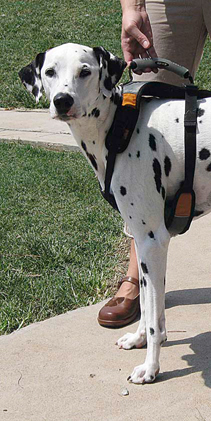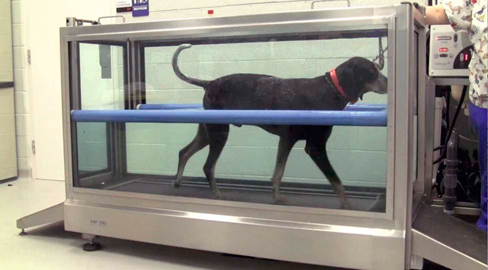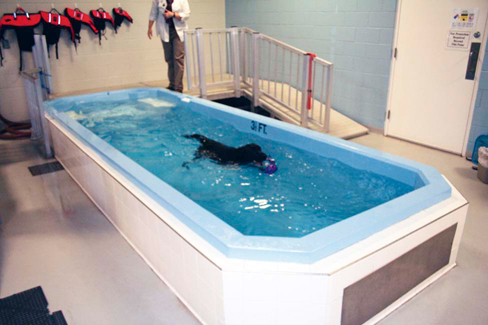Rehabilitation can be prescribed for: • Presurgical and postsurgical procedures • Recumbent patients, such as trauma or neurologic cases • Increased mobility and strength in geriatric animals • Pain management of injured and geriatric animals • Conditioning canine athletes Two scenarios exist for establishing a rehabilitation practice; a stand-alone facility or a facility associated with a veterinary practice. Both have advantages and disadvantages. A stand-alone rehabilitation facility offers the advantage of focusing on only rehabilitation with a team of veterinarians, physical therapists, technicians, and other support staff. A rehabilitation facility within a veterinary practice may be able to optimize benefits to patients by providing total patient care. Integration with a regular veterinary practice allows one to take advantage of economies of scale, especially when considering the purchase and use of expensive diagnostic equipment such as radiographic, ultrasound, and other imaging equipment. The ability to take a radiograph at a rehabilitation facility can be more efficient for the client if additional information is required for the therapist. In a stand-alone rehabilitation facility all pertinent information must be forwarded to the practitioner before the initial evaluation. Of course professionalism and sensitivity to professional relationships must be considered in a rehabilitation facility housed in a veterinary clinic. Patient evaluation is the most critical component of the process because therapeutic protocols are established based on problems identified during the evaluation. As with humans, rehabilitation of animals involves numerous types and degrees of care. When the evaluation process is thorough, logical, and based on sound clinical fundamentals, positive results can be expected. By following a structured program the results may be further improved. The evaluation will determine the primary, secondary, and possibly tertiary problems with which the dog presents. After the problems are identified, the goals are established and the respective treatments are outlined. Specific considerations for each animal should be considered as well. For example aquatic therapy (Figures 38-1 and 38-2) may not be applicable to every dog for a variety of reasons. The basic rules for a successful practice may be summarized as follows: As the process progresses, it cannot be stressed enough that the key to success in any worthwhile endeavor is to align yourself with the correct team. It is not difficult to pick the best and brightest individuals who can help you succeed. Canine rehabilitation is a relatively new field and it is important to examine clinics established in different areas of the country. In addition most cities have Small Business Administration (SBA) offices that can be wonderful resources for each of the points discussed in this chapter. Attributes of each of the elements should include: • Brochures should be colorful, informative, and uncomplicated. • Web sites should be innovative, easy to navigate, informative, customer friendly, and dynamic. A static (not often changed) Web page can be more harmful than helpful. • Web blogs can draw countless people to your Web site. Social media like Twitter, Facebook, and Pinterest allow you to contact numerous people with short, logical updates. Any blog visited should provide the opportunity to comment, which should be used to drive traffic to the practice blog or Web site. • Target marketing to the consumer helps to define the specialty area and narrows the focus of marketing to particular groups such as clubs that participate in agility, tracking, lure coursing, and so on. • Print advertising can take many forms, including articles written about the facility and the services performed. This media is probably considered more “promotion” than advertising, but the fact that the facility appears in print is the important point for branding and self-promotion. • Cable TV is effective and relatively low cost in most areas. Cable companies do a terrific job of targeting the message to the area you specify. The key is to create a commercial that is eye catching and memorable. A professional presentation that focuses on the practice’s strengths draws attention to the services provided. Promotion of the practice will be assisted by creating a commercial that includes a tag line that is memorable. Repeatability is one of the keys to successful television advertising. Crafting your spot to make it adjustable offers much flexibility and gives the most efficient use of money. Placement of the commercial on specific stations is paramount and is based on demographic information for your area. This information should be thoroughly researched before signing a contract. • Promotion through continuing education is easy and can cost relatively little. Hosting or participating in educational seminars, hosting an open house, volunteering to speak at dog club events about the benefits of rehabilitation, or participating in local pet expos is a great way to get the word out about your practice and promote the amazing things that rehabilitation can accomplish for a client’s animals. • Advertise your success stories on your Web site, social media, and clinic with many photographs, quotes from owners, and progressions. People love to hear success stories about animals, especially heartwarming stories. • Word of mouth in the canine world should never be underestimated. Happy clients refer more clients. Each time an existing client refers a client, a personalized letter or card of gratitude should be sent. • Marketing to referral sources will encompass all of the preceding points. In addition, meetings with referring veterinarians and regular in-service training programs to the staff should be part of the marketing plan. Packets of brochures, referral pads, and other marketing materials such as magnets and pens should be distributed to potential referral sources. Computer software programs may be used to track referral sources and the number of referrals from each clinic. Communication with the referring veterinarians and clinics through evaluation letters, progress notes, and discharge summaries will enhance the relationship. • Be certain to obtain written permission from the owner before posting any pictures of their animal or information about the patient or owner. • Evaluation for illness or other rehabilitation services • Pool/treadmill/manual manipulation • Specialized equipment, such as therapeutic laser • Specialized treatments, such as acupuncture or chiropractic manipulation
Development of a Rehabilitation Facility for Small Animals and Business Considerations

Why Consider a Rehabilitation Enterprise?
Creating a Sound Business Strategy
Marketing and Advertising
Overhead and Burden
![]()
Stay updated, free articles. Join our Telegram channel

Full access? Get Clinical Tree


Development of a Rehabilitation Facility for Small Animals and Business Considerations
Only gold members can continue reading. Log In or Register to continue


